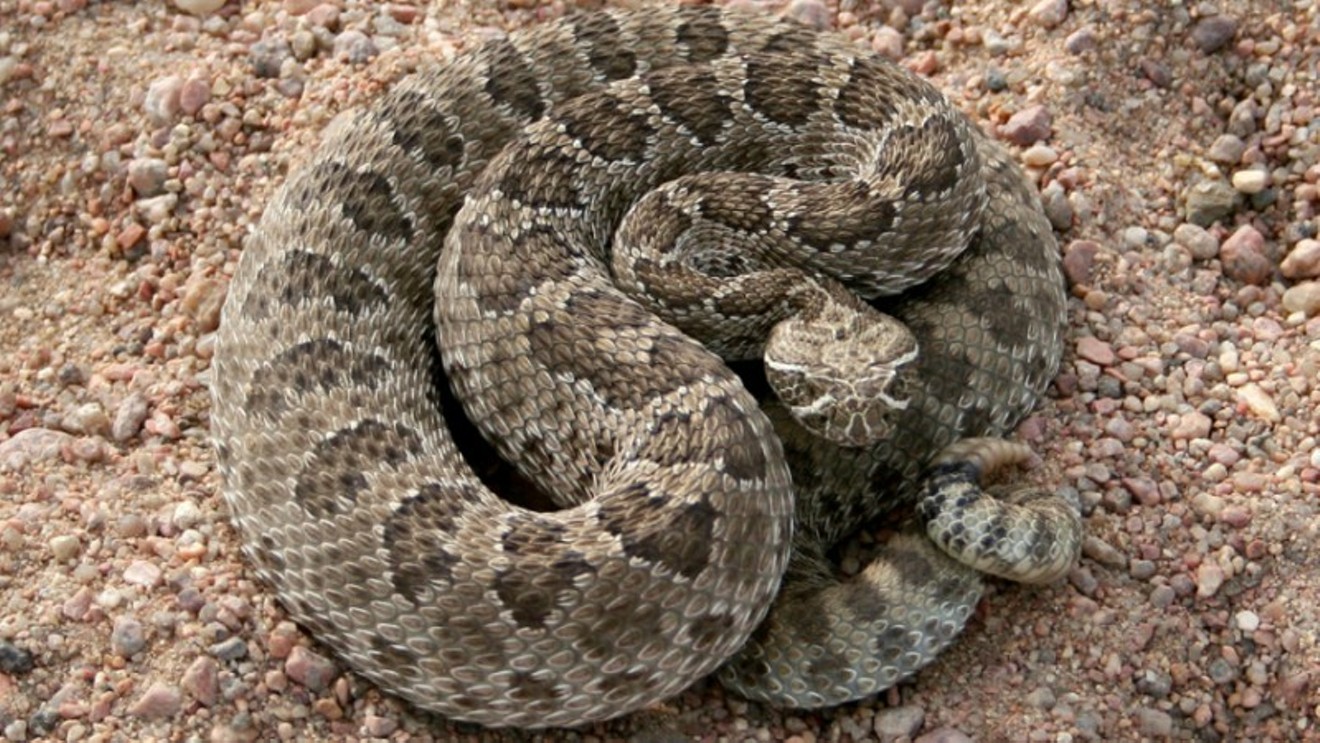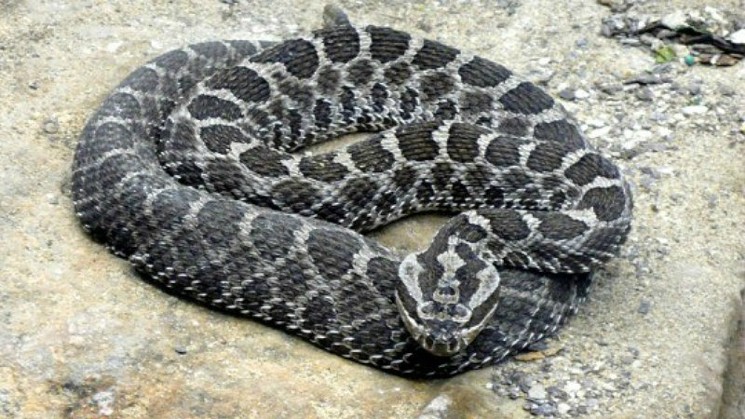But although Tina Jackson, species conservation coordinator for Colorado Parks and Wildlife, urges folks to follow six basic rattlesnake safety tips laid out below, she doesn't want anyone to be so paralyzed by fear that they miss experiencing the wonders of nature.
"Most of us are hiking past lots of things we have no idea are hiding in the underbrush beside us," Jackson points out. "That can be scary to some people. But a snake's first thought is to hide from us, and they do a really good job of it. So we should still be getting out and hiking. We just have to be aware."
Mere hours after my interview with Jackson, this advice came in handy. I was walking my dog in an area near a golf course in the Ken-Caryl Ranch area when we encountered a rattler on the edge of the path — and we both lived to tell the tale. A photo of the snake is below, along with a shot I took of another rattlesnake in the same vicinity last year.
The temperatures we've been experiencing of late are the reason rattlesnakes have been more prevalent lately.

This rattlesnake was spotted by yours truly in the Ken-Caryl Ranch area earlier this month.
Photo by Michael Roberts
Still, a rattlesnake's survival instinct tends to take precedence over comfort. According to Jackson, "there are a different things snakes are trying to balance. They sit solidly in the middle of the food chain: They eat insects, small mammals like rodents and little bunnies, and also other snakes, but they also get eaten by a whole lot of other stuff. So they're always thinking, 'How do we keep from being eaten?' And most of the time, snakes want to hide from us. We're bigger than them, so in their minds, we're something that could hurt them."
Jackson notes that "we have over twenty different kinds of snakes in the state" — the complete list is also shared here, along with a CPW guide to Colorado amphibians and reptiles — "but only three of them are venomous, and all of those are rattlesnakes. Of course, all snakes can bite, just like anything with teeth can bite, but we don't have to worry nearly as much about the ones that don't have venom." Bites from non-venomous snakes can be treated like any other animal bite, she divulges.
Bites happen "when a snake feels threatened," Jackson goes on. "In most cases, they're going to hide — and most of our snake species are colored the way they are because it makes them blend in with their environment. Their color pattern makes them hard to see, so if you're walking up, they're going to sit still and assume you'll think they're a piece of dirt or a rock. But if a rattlesnake thinks hiding isn't working, it's going to shake its rattle. That tells whoever is threatening the snake, 'I'm scary and you should be afraid.'"
Some non-venomous snakes, including the bullsnake, another Colorado native, "have figured out this behavior," Jackson reveals. "They'll actually mimic the rattle sound with their breath or by moving in the sand around them. It's really amazing to watch."
In the case of rattlesnakes, however, "they'll strike if the rattle doesn't scare off whatever's threatening them, or if the threat is so close they can't rattle. But mostly, they don't want to strike. Venom is costly for them to produce. But that's their last line of defense."
If you are bitten by a rattlesnake, Jackson's recommendations are simple: "Seek medical treatment. The first thing you should do is call 911, and if you're not in cell range, which is harder and harder not to be, get into cell range and call 911. There aren't a lot of things you can do on your own to treat a venomous snake bite, so just try to stay calm and let the medical professionals take care of it."
Better yet, "don't put yourself in the position to get bitten," Jackson maintains. "When you're hiking or climbing, pay attention to where you're putting your feet and your hands, and pay attention to where your kids and your dogs are. If you're walking across a grassland or somewhere that doesn't have a grooved trail, wear close-toed shoes and long pants — anything that gives you a bit of coverage. And don't play with snakes. And if you see one on the trail, don't try to pick it up and move it off."
She elaborates on these suggestions in the following blog post, originally written for Colorado Outdoors magazine, a CPW publication. In the meantime, Jackson emphasizes that "if you come across a rattlesnake, give it plenty of room — but enjoy the fact that you're seeing these really remarkable creatures. Because they're amazing."
Especially when seen from a safe distance.
Click to access Colorado Parks and Wildlife's "Quick Key to Amphibians and Reptiles of Colorado." Continue to read Tina Jackson's six tips for rattlesnake safety, followed by a list of non-venomous and venomous snakes native to Colorado.
COLORADO RATTLESNAKES: WHAT SPORTSMEN SHOULD KNOW
By Tina Jackson
1. Rattlesnakes Prefer to Hide
Rattlesnakes are cryptic and use camouflage as their first line of defense. They would rather hide than interact with humans or other animals. Because of their coloration, most rattlesnakes blend in with their surroundings exceptionally well. In most cases, they will simply ignore you, thinking that you cannot see them. However, if the snake coils up and rattles, you are too close and should move away slowly. Stepping back just a few feet can be enough to convince the snake that you are not a threat. Most rattlesnakes will not strike at people unless they feel threatened or are deliberately provoked.
2. Don’t Touch Any Snake
Even though only three of our native snakes are venomous, all snakes have teeth and know how to use them. Regardless of the species, it’s a good idea never to handle any snake. Contrary to popular belief, snakes don’t need to be moved off a trail or “helped” anywhere, although a snake using the road as a heating pad might appreciate some coaxing to the shoulder. Most people get bit on the hands, so you can limit your chances by keeping your digits out of range.
3. Watch Where You Put Your Feet and Hands
Remember: Snakes like to hide. So on rocky trails or areas with downed trees, be sure to check what’s on the other side before putting your appendage there. It’s also a good idea to avoid hiking in tall grass where you cannot see what’s lurking below. Move slowly and use a walking stick to check what lies ahead before stepping forward. A pair of snake-proof boots or high-top hiking boots can provide additional protection if you are walking in known rattlesnake country. When hiking, it’s also best to leave the iPod at home so you can hear a snake’s warning rattle.
4. Keep Dogs Close to You
Dogs are curious and snakes are defensive — a bad combination. Unfortunately, a snake isn’t going to take the time to determine if that large, canine nose headed in their direction is a curious domestic dog or a wild coyote or fox that is searching for a snake dinner. On hiking trips, you should keep dogs on a short leash. Hunters using bird dogs should be especially mindful of rattlesnakes during dove season and the early part of pheasant season prior to the first winter freeze. Training your hunting dog to avoid snakes may also help prevent bites. Although somewhat controversial, some veterinarians are now administering a rattlesnake vaccine, which can help minimize the effects of a snakebite. It’s best to check with your veterinarian for recommendations, as opinions and treatments vary. If a dog gets bitten, it’s important to seek veterinary treatment as soon as possible.
5. If You Get Bitten by a Snake, Don’t Panic
As mentioned above, most snakes in Colorado are not venomous. But no matter what species administered the bite, the best option is to have it looked at by a doctor. Don’t try any of the Western remedies you’ve heard about like cutting open the bite and attempting to suck out the venom. Leave the bite alone and seek medical attention as quickly as possible. The best 'first-aid kit' for a snake bite is your cell phone and car keys. If possible, call ahead to the medical facility so doctors can be prepared with the appropriate treatments.
6. Remember: Snakes Benefit Our Ecosystems
A bullsnake coils to defend itself. Bullsnakes are often mistaken as rattlesnakes because of their ability to mimic rattling sounds by shaking their tail. Like other snakes, bullsnakes help manage rodent populations. All snakes, including rattlesnakes, play an important role in balancing our ecosystems. Snakes eat rats, mice, prairie dogs, and they help control insects and other “pests.” Snakes also sit in the middle of the food chain, providing food for raptors and other predators. Respect and enjoy snakes when you see them in the wild.
By taking these simple precautions, it will help ensure that your time spent in the outdoors this spring and summer is both safe and enjoyable.
Non-venomous snakes native to Colorado:
Black-necked Gartersnake
Brown Snake
California Kingsnake and Speckled Kingsnake
Chihuahuan Nightsnake and Desert Nightsnake
Coachwhip
Common Garter Snake
Eastern Hog-nosed Snake
Eastern Hog-nosed Snake
Glossy Snake
Gophersnake/Bullsnake
Great Plains Ratsnake
Lined Snake
Long-nosed Snake
Milksnake
Northern Watersnake
Plains Black-headed Snake
Plains Gartersnake
Plains Hog-nosed Snake
Ring-necked Snake
Smiths Black-headed Snake
Smooth Greensnake
Striped Whipsnake
Terrestrial Gartersnake
Texas Threadsnake
Western Groundsnake
Western Ribbonsnake
Rubber Boa
Venomous snakes native to Colorado:
Massasauga Rattlesnake
Midget Faded Rattlesnake (Western Rattlesnake)
Prairie Rattlesnake














